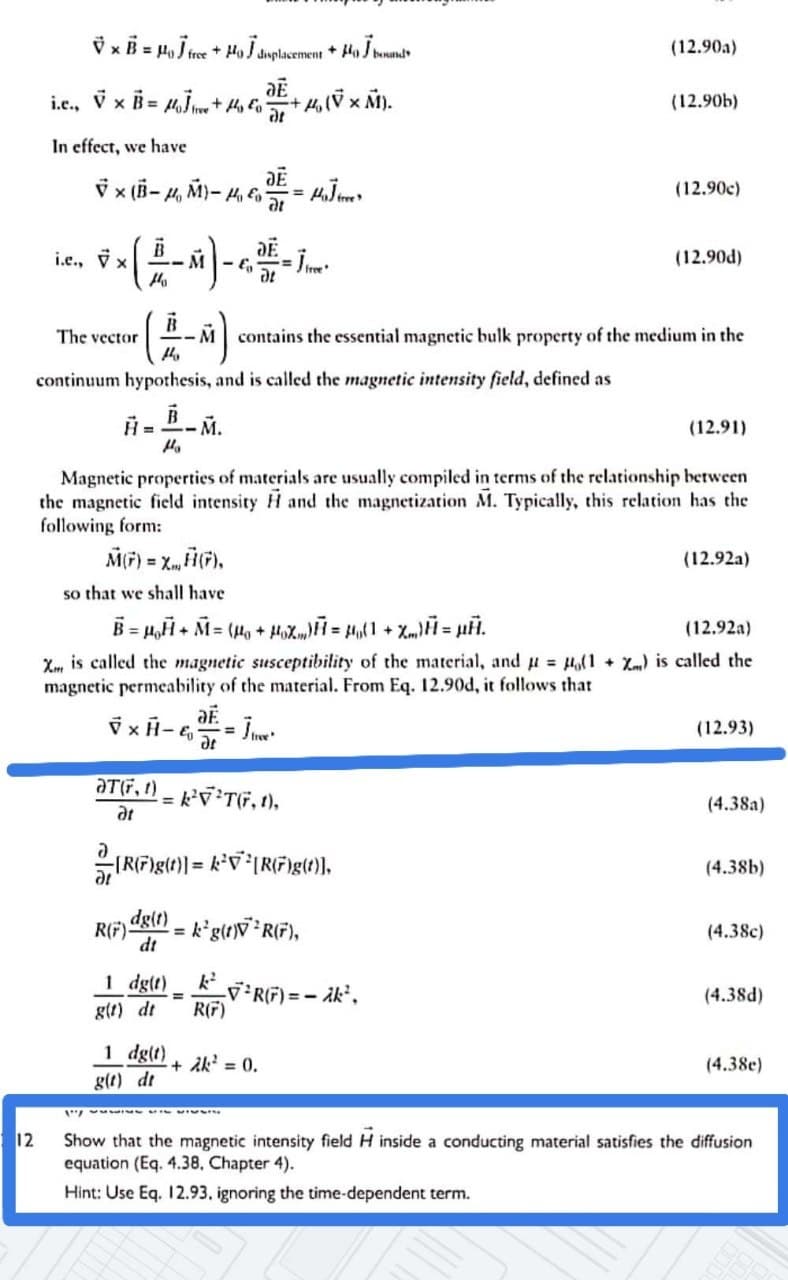(12.90a) free displacement + H. i.c., v x B = HJe+ H, fo (12.90b) frve In effect, we have V x (B- 4, M)- H, Eo (12.90c) %3D at i.c., V x DE -- M-E (12.90d) The vector M contains the essential magnetic bulk property of the medium in the continuum hypothesis, and is called the magnetic intensity field, defined as -M. (12.91) Magnetic properties of materials are usually compiled in terms of the relationship between the magnetic field intensity H and the magnetization M. Typically, this relation has the following form: M7) = x.FiG), (12.92a) %3D so that we shall have (12.92a) X, is called the magnetic susceptibility of the material, and u H,(1 +X) is called the magnetic permeability of the material. From Eq. 12.90d, it follows that V xH- e (12.93) aT(F, 1) at (4.38a) %3D (4.38b) at %3D dt k'gu*R(F), (4.38c) 1 dgt) VR(F) = - ik² , R(F) (4.38d) %3D g(r) dt 1 dgt) + ik = 0. (4.38e) g(t) di 12 Show that the magnetic intensity field H inside a conducting material satisfies the diffusion equation (Eq. 4.38, Chapter 4). Hint: Use Eq. 12.93. ignoring the time-dependent term.
(12.90a) free displacement + H. i.c., v x B = HJe+ H, fo (12.90b) frve In effect, we have V x (B- 4, M)- H, Eo (12.90c) %3D at i.c., V x DE -- M-E (12.90d) The vector M contains the essential magnetic bulk property of the medium in the continuum hypothesis, and is called the magnetic intensity field, defined as -M. (12.91) Magnetic properties of materials are usually compiled in terms of the relationship between the magnetic field intensity H and the magnetization M. Typically, this relation has the following form: M7) = x.FiG), (12.92a) %3D so that we shall have (12.92a) X, is called the magnetic susceptibility of the material, and u H,(1 +X) is called the magnetic permeability of the material. From Eq. 12.90d, it follows that V xH- e (12.93) aT(F, 1) at (4.38a) %3D (4.38b) at %3D dt k'gu*R(F), (4.38c) 1 dgt) VR(F) = - ik² , R(F) (4.38d) %3D g(r) dt 1 dgt) + ik = 0. (4.38e) g(t) di 12 Show that the magnetic intensity field H inside a conducting material satisfies the diffusion equation (Eq. 4.38, Chapter 4). Hint: Use Eq. 12.93. ignoring the time-dependent term.
University Physics Volume 1
18th Edition
ISBN:9781938168277
Author:William Moebs, Samuel J. Ling, Jeff Sanny
Publisher:William Moebs, Samuel J. Ling, Jeff Sanny
Chapter15: Oscillations
Section: Chapter Questions
Problem 66AP: Assume that a pendulum used to drive a grandfather clock has a length L0=1.00 m and a mass M at...
Related questions
Question
i need the answer quickly

Transcribed Image Text:V x B = H, J trce + H, J duplacement * Ho J benand
(12.90a)
i.c., v x B = MJme+ H, lo
(12.90b)
frve
In effect, we have
JE
i x (B- H, M)- H, E
(12.90c)
i.e., V x
- M- E
Ho
(12.90d)
The vector
contains the essential magnetic bulk property of the medium in the
continuum hypothesis, and is called the magnetic intensity field, defined as
BM.
H =
Ho
(12.91)
Magnetic properties of materials are usually compiled in terms of the relationship between
the magnetic field intensity H and the magnetization M. Typically, this relation has the
following form:
= X.
(12.92a)
so that we shall have
B = H,H + M = (H, + HoX„) = H,(1 + Xm)H= uH.
(12.92a)
X. is called the magnetic susceptibility of the material, and u = H(1+ X) is called the
magnetic permeability of the material. From Eq. 12.90d, it follows that
(12.93)
(4.38a)
%3D
at
IR(F)g(t)| =
(4.38b)
dgt)
R(F)-
k'gtV*R(F),
(4.38c)
dt
1 dgt)
_v*R(F) = - ik,
R(F)
(4.38d)
%3D
g(t) dt
1 dg(t)
+ ik = 0.
(4.38e)
g(t) de
12
Show that the magnetic intensity field H inside a conducting material satisfies the diffusion
equation (Eq. 4.38, Chapter 4).
Hint: Use Eq. I2.93, ignoring the time-dependent term.
Expert Solution
This question has been solved!
Explore an expertly crafted, step-by-step solution for a thorough understanding of key concepts.
Step by step
Solved in 2 steps

Knowledge Booster
Learn more about
Need a deep-dive on the concept behind this application? Look no further. Learn more about this topic, physics and related others by exploring similar questions and additional content below.Recommended textbooks for you

University Physics Volume 1
Physics
ISBN:
9781938168277
Author:
William Moebs, Samuel J. Ling, Jeff Sanny
Publisher:
OpenStax - Rice University

Classical Dynamics of Particles and Systems
Physics
ISBN:
9780534408961
Author:
Stephen T. Thornton, Jerry B. Marion
Publisher:
Cengage Learning

Principles of Physics: A Calculus-Based Text
Physics
ISBN:
9781133104261
Author:
Raymond A. Serway, John W. Jewett
Publisher:
Cengage Learning

University Physics Volume 1
Physics
ISBN:
9781938168277
Author:
William Moebs, Samuel J. Ling, Jeff Sanny
Publisher:
OpenStax - Rice University

Classical Dynamics of Particles and Systems
Physics
ISBN:
9780534408961
Author:
Stephen T. Thornton, Jerry B. Marion
Publisher:
Cengage Learning

Principles of Physics: A Calculus-Based Text
Physics
ISBN:
9781133104261
Author:
Raymond A. Serway, John W. Jewett
Publisher:
Cengage Learning
